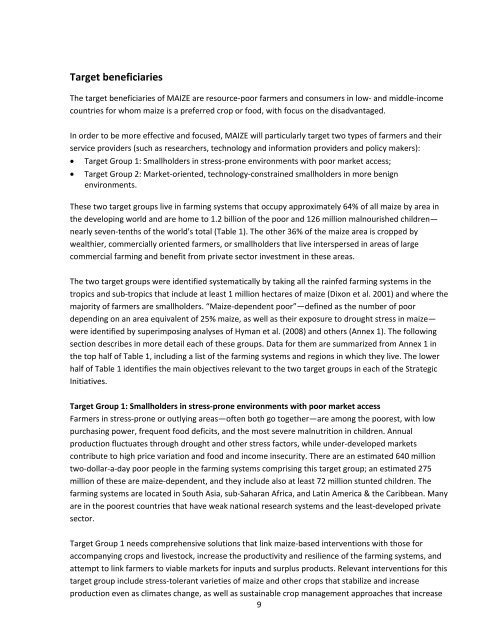Download - Maize
Download - Maize
Download - Maize
Create successful ePaper yourself
Turn your PDF publications into a flip-book with our unique Google optimized e-Paper software.
Target beneficiaries<br />
The target beneficiaries of MAIZE are resource‐poor farmers and consumers in low‐ and middle‐income<br />
countries for whom maize is a preferred crop or food, with focus on the disadvantaged.<br />
In order to be more effective and focused, MAIZE will particularly target two types of farmers and their<br />
service providers (such as researchers, technology and information providers and policy makers):<br />
Target Group 1: Smallholders in stress‐prone environments with poor market access;<br />
<br />
Target Group 2: Market‐oriented, technology‐constrained smallholders in more benign<br />
environments.<br />
These two target groups live in farming systems that occupy approximately 64% of all maize by area in<br />
the developing world and are home to 1.2 billion of the poor and 126 million malnourished children—<br />
nearly seven‐tenths of the world's total (Table 1). The other 36% of the maize area is cropped by<br />
wealthier, commercially oriented farmers, or smallholders that live interspersed in areas of large<br />
commercial farming and benefit from private sector investment in these areas.<br />
The two target groups were identified systematically by taking all the rainfed farming systems in the<br />
tropics and sub‐tropics that include at least 1 million hectares of maize (Dixon et al. 2001) and where the<br />
majority of farmers are smallholders. “<strong>Maize</strong>‐dependent poor”—defined as the number of poor<br />
depending on an area equivalent of 25% maize, as well as their exposure to drought stress in maize—<br />
were identified by superimposing analyses of Hyman et al. (2008) and others (Annex 1). The following<br />
section describes in more detail each of these groups. Data for them are summarized from Annex 1 in<br />
the top half of Table 1, including a list of the farming systems and regions in which they live. The lower<br />
half of Table 1 identifies the main objectives relevant to the two target groups in each of the Strategic<br />
Initiatives.<br />
Target Group 1: Smallholders in stress‐prone environments with poor market access<br />
Farmers in stress‐prone or outlying areas—often both go together—are among the poorest, with low<br />
purchasing power, frequent food deficits, and the most severe malnutrition in children. Annual<br />
production fluctuates through drought and other stress factors, while under‐developed markets<br />
contribute to high price variation and food and income insecurity. There are an estimated 640 million<br />
two‐dollar‐a‐day poor people in the farming systems comprising this target group; an estimated 275<br />
million of these are maize‐dependent, and they include also at least 72 million stunted children. The<br />
farming systems are located in South Asia, sub‐Saharan Africa, and Latin America & the Caribbean. Many<br />
are in the poorest countries that have weak national research systems and the least‐developed private<br />
sector.<br />
Target Group 1 needs comprehensive solutions that link maize‐based interventions with those for<br />
accompanying crops and livestock, increase the productivity and resilience of the farming systems, and<br />
attempt to link farmers to viable markets for inputs and surplus products. Relevant interventions for this<br />
target group include stress‐tolerant varieties of maize and other crops that stabilize and increase<br />
production even as climates change, as well as sustainable crop management approaches that increase<br />
9

















